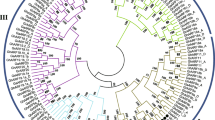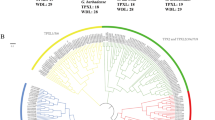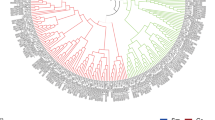Abstract
Cotton fibers are specialized single-cell trichomes derived from epidermal cells, similar to root hairs and trichomes in Arabidopsis. While the MYB-bHLH-WD40 (MBW) complex has been shown to regulate initiation of both root hairs and trichomes in Arabidopsis, the role of their homologous gene in cotton fiber initiation remains unknown. In this study, we identified a R2R3 MYB transcription factor (TF), GhWER, which exhibited a significant increase in expression within the outer integument of ovule at -1.5 DPA (days post anthesis). Its expression peaked at -1 DPA and then gradually decreased. Knockout of GhWER using CRISPR technology inhibited the initiation and early elongation of fiber initials, resulting in the shorter mature fiber length. Additionally, GhWER interacted with two bHLH TF, GhDEL65 and GhbHLH121, suggesting a potential regulatory complex for fiber development. RNA-seq analysis of the outer integument of the ovule at -1.5 DPA revealed that the signal transduction pathways of ethylene, auxin and gibberellin were affected in the GhWER knockout lines. Further examination demonstrated that GhWER directly activated ethylene signaling genes, including ACS1 and ETR2. These findings highlighted the biological function of GhWER in regulating cotton fiber initiation and early elongation, which has practical significance for improving fiber quality and yield.






Similar content being viewed by others
Data availability
The RNA-seq data have been deposited in the NCBI SRA database (https://www.ncbi.nlm.nih.gov/bioproject/) with BioProject number PRJNA1064389. For any other data inquiries, interested parties can contact the corresponding authors and request access.
References
Applequist W, Cronn R, Wendel J (2001) Comparative development of fiber in wild and cultivated cotton. Evol Dev 3(1):3–17. https://doi.org/10.1046/j.1525-142X.2001.00079.x
Bernhardt C, Lee MM, Gonzalez A, Zhang F, Lloyd A, Schiefelbein J (2003) The bHLH genes GLABRA3 (GL3) and ENHANCER OF GLABRA3 (EGL3) specify epidermal cell fate in the Arabidopsis root. Development 130(26):6431–6439. https://doi.org/10.1242/dev.00880
Chen D, Jin Q, Pan J, Liu Y, Tang Y, E Y, Xu L, Yang T, Qiu J, Chen X, Wang J, Gong D, Ge X, Li Z, Cui C (2023) Fine mapping of genes controlling pigment accumulation in oilseed rape (Brassica napus L.). Mol Breed 43(3). https://doi.org/10.1007/s11032-023-01365-5
Gan Y, Liu C, Yu H, Broun P (2007a) Integration of cytokinin and gibberellin signalling by Arabidopsis transcription factors GIS, ZFP8 and GIS2 in the regulation of epidermal cell fate. Development 134(11):2073–2081. https://doi.org/10.1242/dev.005017
Gan Y, Yu H, Peng J, Broun P (2007b) Genetic and molecular regulation by DELLA proteins of trichome development in Arabidopsis. Plant Physiol 145(3):1031–1042. https://doi.org/10.1104/pp.107.104794
Guan X, Pang M, Nah G, Shi X, Ye W, Stelly DM, Chen ZJ (2014) miR828 and miR858 regulate homoeologous MYB2 gene functions in Arabidopsis trichome and cotton fibre development. Nat Commun 5:3050. https://doi.org/10.1038/ncomms4050
Hao J, Tu L, Hu H, Tan J, Deng F, Tang W, Nie Y, Zhang X (2012) GbTCP, a cotton TCP transcription factor, confers fibre elongation and root hair development by a complex regulating system. J Exp Bot 63(17):6267–6281. https://doi.org/10.1093/jxb/ers278
Hu H, Wang M, Ding Y, Zhu S, Zhao G, Tu L, Zhang X (2018) Transcriptomic repertoires depict the initiation of lint and fuzz fibres in cotton (Gossypium hirsutum L.). Plant Biotechnol J 16(5):1002–1012. https://doi.org/10.1111/pbi.12844
Huang Y, Liu X, Tang K, Zuo K (2013) Functional analysis of the seed coat-specific gene GbMYB2 from cotton. Plant Physiol Biochem 73:16–22. https://doi.org/10.1016/j.plaphy.2013.08.004
Jin S, Zhang X, Nie Y, Guo X, Liang S, Zhu H (2006a) Identification of a novel elite genotype for in vitro culture and genetic transformation of cotton. Biol Plantarum 50(4):519–524. https://doi.org/10.1007/s10535-006-0082-5
Jin SX, Liang SG, Zhang XL, Nie YC, Guo XP (2006b) An efficient grafting system for transgenic plant recovery in cotton (Gossypium hirsutum L.). Plant Cell Tiss Org 85(2):181–185. https://doi.org/10.1007/s11240-005-9068-9
Lee MM, Schiefelbein J (1999) WEREWOLF, a MYB-related protein in arabidopsis, is a position-dependent regulator of epidermal cell patterning. Cell 99(5):473–483. https://doi.org/10.1016/S0092-8674(00)81536-6
Lee JJ, Woodward AW, Chen ZJ (2007) Gene Expression Changes and Early Events in Cotton Fibre Development. Ann Bot 100(7):1391–1401. https://doi.org/10.1093/aob/mcm232
Lepiniec L, Debeaujon I, Routaboul J-M, Baudry A, Pourcel L, Nesi N, Caboche M (2006) Genetics and Biochemistry of Seed Flavonoids. Annu Rev Plant Biol 57(1):405–430. https://doi.org/10.1146/annurev.arplant.57.032905.105252
Liu Q, Wang C, Jiao XZ, Zhang HW, Song LL, Li YX, Gao CX, Wang KJ (2019) Hi-TOM: a platform for high-throughput tracking of mutations induced by CRISPR/Cas systems. Sci China Life Sci 62(1):1–7. https://doi.org/10.1007/s11427-018-9402-9
Machado A, Wu Y, Yang Y, Llewellyn DJ, Dennis ES (2009) The MYB transcription factor GhMYB25 regulates early fibre and trichome development. Plant J 59(1):52–62. https://doi.org/10.1111/j.1365-313X.2009.03847.x
Naoumkina M, Zeng L, Fang DD, Wang M, Thyssen GN, Florane CB, Li P, Delhom CD (2020) Mapping and validation of a fiber length QTL on chromosome D11 using two independent F2 populations of upland cotton. Molecular Breeding 40(3). https://doi.org/10.1007/s11032-020-01111-1
Oppenheimer DG, Herman PL, Sivakumaran S, Esch J, Marks MD (1991) A Myb Gene Required for Leaf Trichome Differentiation in Arabidopsis Is Expressed in Stipules. Cell 67(3):483–493. https://doi.org/10.1016/0092-8674(91)90523-2
Paterson AH, Wendel JF, Gundlach H, Guo H, Jenkins J, Jin D, Llewellyn D, Showmaker KC, Shu S, Udall J, Yoo MJ, Byers R, Chen W, Doron-Faigenboim A, Duke MV, Gong L, Grimwood J, Grover C, Grupp K, Hu G, Lee TH, Li J, Lin L, Liu T, Marler BS, Page JT, Roberts AW, Romanel E, Sanders WS, Szadkowski E, Tan X, Tang H, Xu C, Wang J, Wang Z, Zhang D, Zhang L, Ashrafi H, Bedon F, Bowers JE, Brubaker CL, Chee PW, Das S, Gingle AR, Haigler CH, Harker D, Hoffmann LV, Hovav R, Jones DC, Lemke C, Mansoor S, Ur Rahman M, Rainville LN, Rambani A, Reddy UK, Rong JK, Saranga Y, Scheffler BE, Scheffler JA, Stelly DM, Triplett BA, Van Deynze A, Vaslin MF, Waghmare VN, Walford SA, Wright RJ, Zaki EA, Zhang T, Dennis ES, Mayer KF, Peterson DG, Rokhsar DS, Wang X, Schmutz J (2012) Repeated polyploidization of Gossypium genomes and the evolution of spinnable cotton fibres. Nature 492(7429):423–427. https://doi.org/10.1038/nature11798
Payne C, Zhang F, Lloyd A (2000) GL3 Encodes a bHLH Protein That Regulates Trichome Development in Arabidopsis Through Interaction With GL1 and TTG1. Genetics 156:1349–1362
Pu L, Li Q, Fan X, Yang W, Xue Y (2008) The R2R3 MYB transcription factor GhMYB109 is required for cotton fiber development. Genetics 180(2):811–820. https://doi.org/10.1534/genetics.108.093070
Qi TC, Song SS, Ren QC, Wu DW, Huang H, Chen Y, Fan M, Peng W, Ren CM, Xie DX (2011) The Jasmonate-ZIM-Domain Proteins Interact with the WD-Repeat/bHLH/MYB Complexes to Regulate Jasmonate-Mediated Anthocyanin Accumulation and Trichome Initiation in Arabidopsis thaliana. Plant Cell 23(5):1795–1814. https://doi.org/10.1105/tpc.111.083261
Qi T, Huang H, Wu D, Yan J, Qi Y, Song S, Xie D (2014) Arabidopsis DELLA and JAZ proteins bind the WD-repeat/bHLH/MYB complex to modulate gibberellin and jasmonate signaling synergy. Plant Cell 26(3):1118–1133. https://doi.org/10.1105/tpc.113.121731
Qin Y, Sun M, Li W, Xu M, Shao L, Liu Y, Zhao G, Liu Z, Xu Z, You J, Ye Z, Xu J, Yang X, Wang M, Lindsey K, Zhang X, Tu L (2022) Single-cell RNA-seq reveals fate determination control of an individual fibre cell initiation in cotton (Gossypium hirsutum). Plant Biotechnol J 20(12):2372–2388. https://doi.org/10.1111/pbi.13918
Ramsay NA, Glover BJ (2005) MYB–bHLH–WD40 protein complex and the evolution of cellular diversity. Trends Plant Sci 10(2):63–70. https://doi.org/10.1016/j.tplants.2004.12.011
Rerie WG, Feldmann KA, Marks MD (1994) The GLABRA2 gene encodes a homeo domain protein required for normal trichome development in Arabidopsis. Genes Dev 8(12):1388–1399. https://doi.org/10.1101/gad.8.12.1388
Shangguan XX, Yang CQ, Zhang XF, Wang LJ (2016) Functional characterization of a basic helix-loop-helix (bHLH) transcription factor GhDEL65 from cotton (Gossypium hirsutum). Physiol Plant 158(2):200–212. https://doi.org/10.1111/ppl.12450
Shi YH, Zhu SW, Mao XZ, Feng JX, Qin YM, Zhang L, Cheng J, Wei LP, Wang ZY, Zhu YX (2006) Transcriptome profiling, molecular biological, and physiological studies reveal a major role for ethylene in cotton fiber cell elongation. Plant Cell 18(3):651–664. https://doi.org/10.1105/tpc.105.040303
Shi P, Fu X, Shen Q, Liu M, Pan Q, Tang Y, Jiang W, Lv Z, Yan T, Ma Y, Chen M, Hao X, Liu P, Li L, Sun X, Tang K (2018) The roles of AaMIXTA1 in regulating the initiation of glandular trichomes and cuticle biosynthesis in Artemisia annua. New Phytol 217(1):261–276. https://doi.org/10.1111/nph.14789
Song J, Xu R, Guo Q, Wu C, Li Y, Wang X, Wang J, Qiu L-J (2023) An omics strategy increasingly improves the discovery of genetic loci and genes for seed-coat color formation in soybean. Mol Breed 43 (9). https://doi.org/10.1007/s11032-023-01414-z
Stewart J (1975) Fiber initiation on the cotton ovule (Gossypium hirsutum). Am J Bot 62(7):723–730. https://doi.org/10.1002/j.1537-2197.1975.tb14105.x
Sun LL, Zhang AD, Zhou ZJ, Zhao YQ, Yan A, Bao SJ, Yu H, Gan YB (2015) GLABROUS INFLORESCENCE STEMS3 (GIS3) regulates trichome initiation and development in Arabidopsis. New Phytol 206(1):220–230. https://doi.org/10.1111/nph.13218
Suo J, Liang X, Pu L, Zhang Y, Xue Y (2003) Identification of GhMYB109 encoding a R2R3 MYB transcription factor that expressed specifically in fiber initials and elongating fibers of cotton (Gossypium hirsutum L.). Biochim Biophys Acta 1630(1):25–34. https://doi.org/10.1016/j.bbaexp.2003.08.009
Walford SA, Wu Y, Llewellyn DJ, Dennis ES (2011) GhMYB25-like: a key factor in early cotton fibre development. Plant J 65(5):785–797. https://doi.org/10.1111/j.1365-313X.2010.04464.x
Walker AR, Davison PA, Bolognesi-Winfield AC, James CM, Srinivasan N, Blundell TL, Esch JJ, Marks MD, Gray JC (1999) The TRANSPARENT TESTA GLABRA1 locus, which regulates trichome differentiation and anthocyanin biosynthesis in Arabidopsis, encodes a WD40 repeat protein. Plant Cell 11(7):1337–1349. https://doi.org/10.1105/tpc.11.7.1337
Wang S, Wang JW, Yu N, Li CH, Luo B, Gou JY, Wang LJ, Chen XY (2004) Control of plant trichome development by a cotton fiber MYB gene. Plant Cell 16(9):2323–2334. https://doi.org/10.1105/tpc.104.024844
Wang P, Zhang J, Sun L, Ma Y, Xu J, Liang S, Deng J, Tan J, Zhang Q, Tu L, Daniell H, Jin S, Zhang X (2018) High efficient multisites genome editing in allotetraploid cotton (Gossypium hirsutum) using CRISPR/Cas9 system. Plant Biotechnol J 16(1):137–150. https://doi.org/10.1111/pbi.12755
Wang M, Tu L, Yuan D, Zhu SC, Li J, Liu F, Pei L, Wang P, Zhao G, Ye Z, Huang H, Yan F, Ma Y, Zhang L, Liu M, You J, Yang Y, Liu Z, Huang F, Li B, Qiu P, Zhang Q, Zhu L, Jin S, Yang X, Min L, Li G, Chen LL, Zheng H, Lindsey K, Lin Z, Udall JA, Zhang X (2019) Reference genome sequences of two cultivated allotetraploid cottons, Gossypium hirsutum and Gossypium barbadense. Nat Genet 51(2):224–229. https://doi.org/10.1038/s41588-018-0282-x
Xiao YH, Li DM, Yin MH, Li XB, Zhang M, Wang YJ, Dong J, Zhao J, Luo M, Luo XY, Hou L, Hu L, Pei Y (2010) Gibberellin 20-oxidase promotes initiation and elongation of cotton fibers by regulating gibberellin synthesis. J Plant Physiol 167(10):829–837. https://doi.org/10.1016/j.jplph.2010.01.003
Xiao G, He P, Zhao P, Liu H, Zhang L, Pang C, Yu J (2018) Genome-wide identification of the GhARF gene family reveals that GhARF2 and GhARF18 are involved in cotton fibre cell initiation. J Exp Bot 69(18):4323–4337. https://doi.org/10.1093/jxb/ery219
Xu W, Dubos C, Lepiniec L (2015) Transcriptional control of flavonoid biosynthesis by MYB–bHLH–WDR complexes. Trends Plant Sci 20(3):176–185. https://doi.org/10.1016/j.tplants.2014.12.001
Zhang F, Gonzalez A, Zhao M, Payne CT, Lloyd A (2003) A network of redundant bHLH proteins functions in all TTG1-dependent pathways of Arabidopsis. Development 130(20):4859–4869. https://doi.org/10.1242/dev.00681
Zhang M, Zheng X, Song S, Zeng Q, Hou L, Li D, Zhao J, Wei Y, Li X, Luo M, Xiao Y, Luo X, Zhang J, Xiang C, Pei Y (2011) Spatiotemporal manipulation of auxin biosynthesis in cotton ovule epidermal cells enhances fiber yield and quality. Nat Biotechnol 29(5):453–458. https://doi.org/10.1038/nbt.1843
Zhang T, Hu Y, Jiang W, Fang L, Guan X, Chen J, Zhang J, Saski CA, Scheffler BE, Stelly DM, Hulse-Kemp AM, Wan Q, Liu B, Liu C, Wang S, Pan M, Wang Y, Wang D, Ye W, Chang L, Zhang W, Song Q, Kirkbride RC, Chen X, Dennis E, Llewellyn DJ, Peterson DG, Thaxton P, Jones DC, Wang Q, Xu X, Zhang H, Wu H, Zhou L, Mei G, Chen S, Tian Y, Xiang D, Li X, Ding J, Zuo Q, Tao L, Liu Y, Li J, Lin Y, Hui Y, Cao Z, Cai C, Zhu X, Jiang Z, Zhou B, Guo W, Li R, Chen ZJ (2015) Sequencing of allotetraploid cotton (Gossypium hirsutum L. acc. TM-1) provides a resource for fiber improvement. Nat Biotechnol 33(5):531–537. https://doi.org/10.1038/nbt.3207
Zhang M, Zeng JY, Long H, Xiao YH, Yan XY, Pei Y (2017) Auxin Regulates Cotton Fiber Initiation via GhPIN-Mediated Auxin Transport. Plant Cell Physiol 58(2):385–397. https://doi.org/10.1093/pcp/pcw203
Zhao J, Bai W, Zeng Q, Song S, Zhang M, Li X, Hou L, Xiao Y, Luo M, Li D, Luo X, Pei Y (2015) Moderately enhancing cytokinin level by down-regulation of GhCKX expression in cotton concurrently increases fiber and seed yield. Mol Breed 35(2). https://doi.org/10.1007/s11032-015-0232-6
Zhou Z, Sun L, Zhao Y, An L, Yan A, Meng X, Gan Y (2013) Zinc Finger Protein 6 (ZFP6) regulates trichome initiation by integrating gibberellin and cytokinin signaling in Arabidopsis thaliana. New Phytol 198(3):699–708. https://doi.org/10.1111/nph.12211
Zhu L, Jiang B, Zhu J, Xiao G (2022) Auxin promotes fiber elongation by enhancing gibberellic acid biosynthesis in cotton. Plant Biotechnol J 20(3):423–425. https://doi.org/10.1111/pbi.13771
Funding
This work was supported by grants from the National Natural Science Foundation of China (projects No. 32172071 to lilitu) and National Key R&D Program of China (projects No. 2022YFF1001400 to lilitu).
Author information
Authors and Affiliations
Contributions
L.T. conceived the project and designed the experiments. G.Z., W.L. contributed to the vector construction. W.L., L.S., M.X., M.S. and G.Z. performed the transgenic experiments and phenotype investigation. W.L., L.S., M.X. and G.Z. performed the RNA-seq and qRT-PCR. G.Z. performed the LUC assay. G.Z. and L.T. wrote the manuscript.
Corresponding author
Ethics declarations
Competing interests
The authors declare no competing interests.
Additional information
Publisher's Note
Springer Nature remains neutral with regard to jurisdictional claims in published maps and institutional affiliations.
Supplementary Information
Below is the link to the electronic supplementary material.
Rights and permissions
Springer Nature or its licensor (e.g. a society or other partner) holds exclusive rights to this article under a publishing agreement with the author(s) or other rightsholder(s); author self-archiving of the accepted manuscript version of this article is solely governed by the terms of such publishing agreement and applicable law.
About this article
Cite this article
Zhao, G., Li, W., Xu, M. et al. GhWER controls fiber initiation and early elongation by regulating ethylene signaling pathway in cotton (Gossypium hirsutum). Mol Breeding 44, 38 (2024). https://doi.org/10.1007/s11032-024-01477-6
Received:
Accepted:
Published:
DOI: https://doi.org/10.1007/s11032-024-01477-6




